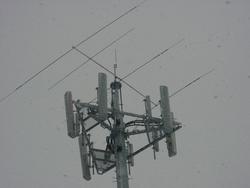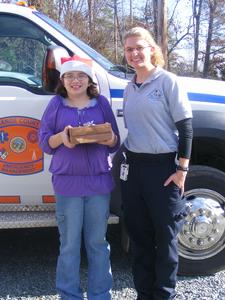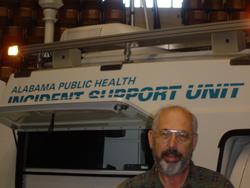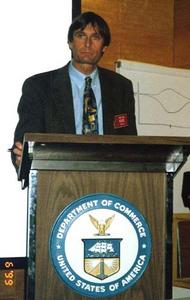 January 21, 2009 Editor: Rick Palm, K1CE | ||||
The View from Flagler County ..... A new year, and a new look for the ARES E-Letter! We hope you will find value added in this new html edition, with photos, graphics and tables. For readers who prefer the text-only version, each message contains both a plain-text version and an HTML version. Your e-mail program can select the one to display. Astute readers will also observe that there are ads. The revenue generated by these advertisements offsets the expense of producing this newsletter and more: It goes to supporting the significant ARRL initiatives in the Amateur Radio emcomm arena, including the ARES program, publications and planning, and a dedicated support staff in Newington. In other words, ad revenue goes to a good cause. And, of course, the ads may be of special interest to emcomm operators. ______ It has been a quiet holiday season for Flagler ARES, but our meeting was held this past Tuesday night at the Flagler firehouse (too late for a report in this issue) to kick off 2009, with only five months before hurricane season.
ARES Docket Marion County, Oregon ARES (MCARES) took part in a semi-annual, state-wide all digital Simulated Emergency Test (SET) on November 15, 2008. After a major winter storm in December 2007, ARES volunteers using HF digital modes were the only means of communication with the Oregon coast. Oregon's governor, Ted Kulongoski, was so impressed with this operation that he appropriated money for ARES digital stations to be setup in all thirty-six counties. Oregon ARES has developed a plan for semi-annual digital SETs to test this equipment and train members. In addition to county emergency operations, MCARES members meet and train with the ARES unit at the Oregon Office of Emergency Management also in Salem and provide support for the HF station at the governor's command post. -- Bill Wylie, KE7EPY, MCARES PIO, Salem, Oregon Massachusetts and New Hampshire, December 11 -- The major ice storm that hit New England resulted in Amateur Radio operators responding to calls for assistance from various served agencies. Eastern Massachusetts SEC Rob Macedo, KD1CY, reported almost 400,000 customers in Massachusetts lost power. Western Massachusetts SEC John Ruggerio, N2YHK, said his ARES units responded to local EOCs. A team in Gardner provided communications for the local hospital and EOC, with message traffic on prescription fills and other priority, but non-emergency traffic, being fulfilled. Eastern Massachusetts ARESMAT supported the operation. Massachusetts State RACES Radio Officer Tom Kinahan, N1CPE, and his team supported the State EOC. New Hampshire ASEC David Colter, WA1ZCN, said his people supported two shelters and EOCs. The Milford animal shelter was also supported for rescue efforts. Giles County (Tennessee) ARES and Tennessee MARS organizations participated in a hurricane drill October 3, 2008 that simulated a total loss of communications state-wide. The Ardmore MARS station and the Pulaski ARES group established a command center at Hillside Hospital, dispatching mobile radio units to the Giles County High School and airport. Message traffic included simulated damage reports, medical/injury reports, and vital statistics to the state EMA EOC in Nashville. -- Bill Hand, AAR4DX, KI4WNH, Public Affairs Officer, Tennessee Army MARS, Ardmore, Tennessee Hams Are The Eyes Of NOAA Near Reno, Nevada -- On Friday, December 19, a major winter storm hit the area bringing with it hurricane force winds to high elevations, such as Virginia Peak, located northeast of Reno near Pyramid Lake. Gusts of over 140 miles per hour battered the mountain, damaging sensitive electronic weather gear, including the NEXRAD radar system used by the National Weather Service office located in Reno. A link is available for viewing the damage. Fortunately, Northwest Nevada has an active SKYWARN program. With the demise of the radar system, NWS Reno asked spotters to assist by providing real-time weather information via Amateur Radio. Dee Arnold, KA7LOZ, took reports at the amateur station, WX7RNO at the NWS Reno office. Arnold said, "We [were] their eyes until the radar site could be accessed and repaired." Spotters were able to file reports on the Wide Area Data Club's (WADG) high level linked system, which covers a good portion of both northern Nevada and north central California. Amateur Radio operators have also been providing highway information over mountain passes during the recent flurry of early winter storms. Thanks to WADG for use of their repeater system. -- Don Carlson, KQ6FM, Nevada Section Emergency Coordinator/ Public Information Coordinator; RACES Radio Officer; Member, ARRL Public Relations Committee NIMS Changes Noted According to a press release, last month the U.S. Department of Homeland Security's (DHS) FEMA released a revised National Incident Management System (NIMS)--the national standard for incident management. NIMS establishes standardized incident management processes, protocols, and procedures that all federal, state, tribal and local responders will use to coordinate and conduct response actions. See the FEMA Fact Sheet, What's New, and FAQs. According to DHS, it has clarified "existing NIMS concepts, better incorporating preparedness and planning and improving the overall readability of the document. The revised document also differentiates between the purposes of NIMS and the National Response Framework (NRF) by identifying how NIMS provides the action template for the management of incidents, while the NRF provides the policy structure and mechanisms for national-level policy for incident management." -- Thanks, Les Rayburn, N1LF, via the Emergency-Management Group at Yahoo.com The updated National Incident Management System (NIMS) course is now available. - Dennis Dura, K2DCD, ARRL Emergency Preparedness and Response Manager Southeastern D-STAR Net A Success The Southeastern D-STAR Weather Net was created using the D-STAR digital voice and data technology to allow amateurs to link systems and communicate across the southeastern US, an area prone to severe weather conditions. With the rapidly growing number of D-STAR users and repeaters across the Southeast, the ability to use these systems to communicate across the wide area and support emergency communications has been created. Alabama was an early leader with a statewide deployment of D-STAR repeaters. Georgia is creating a statewide network of D-STAR repeaters using the television towers of Georgia Public Broadcasting. South Carolina plans to overlay their existing statewide network of analog repeaters with D-STAR repeaters. Many areas of Florida are already covered with D-STAR systems. The weekly net allows training in net communications over a wide area digital network of linked repeaters. Check-ins are facilitated using the "quick key" format. Since call signs are automatically included with each D-STAR transmission, users simply key for one second to send their call. Net Control sees all call signs and recognizes each station. The net was used during last summer's hurricane season linking several EOCs across the southeast. During the winter "off season" for severe weather, a short program is being presented every other week during the net on topics such as repeater linking and the D-RATS data software. Each week, 35 to 40 stations on 17 to 25 repeaters across the southeast check into the weekly net. The net takes place each Sunday evening beginning at 9:00 pm ET, 8:00 pm CT. D-STAR users should check with their local D-STAR repeater operators to see if they participate in the net. More info or contact John Davis. -- John A. Davis, WB4QDX, District Emergency Coordinator - GPB, Georgia Section ARES New Madrid Fault Report Link [Last month's item had a busted link on the New Madrid Fault report. Here is the item and a better link - ed.] The U.S. DHS/FEMA has just released a comprehensive new report on the threat and it contains a wealth of information for those who may be planning exercises. The complete report is a large PDF file, but well worth the download time. San Diego Quantifies Amateur EmComms in Antenna Defense Bid Former ARRL Directors Fried Heyn, WA6WZO, and Art Goddard, W6XD, report a fine joint San Diego (California) DX Club and ARES effort to quantify the value of amateur emcomms to the city. The documentation is in defense of amateur antenna interests: Amateur Radio Public Service Benefits to the City of San Diego, January 2009. Every reader should look at this document; it is a superb effort that could be emulated in other parts of the country. It's something we should be doing all of the time. A National-level effort is also to be initiated, per Goddard. -- Thanks, WA6WZO and W6XD Erie (PA) Red Cross ARA Antennas on Cell Tower
The Erie Red Cross Amateur Radio Association (W3ERC) of Pennsylvania enhances American Red Cross (ARC) volunteer activity via Amateur Radio and provides a cadre of trained ARC communicators for local and national emergency communications. Thanks to a new Verizon Cell Tower, new antennas are up: In addition to a pair of 2-meter Verticals and a 440 MHz Vertical at the 50 foot level, a Cushcraft A4S tri-band Yagi sits snugly atop the cell tower at the 110' mark. All have enhanced our repeater and HF coverage, and thus our emcomm capabilities. -- Dan Miller, K3UFG, Assistant Director, Emergency Services, Greater Erie County Red Cross Chapter Letters: New Madrid Fault Prep See the Tennessee Emergency Management Agency Web site, and scroll down to the second article, on Tennessee, Kentucky, and other efforts to prepare for a New Madrid Fault casualty event. Not only have we participated in professional exercises sponsored by our State emergency management agencies, we have also involved the Central United States Earthquake Consortium (CUSEC), and the TRI-MARS services in many recent exercises that provide an excellent example of complete interoperability among the affected States, especially Tennessee and Kentucky, their many affected counties, and the various communications services involved. In Tennessee alone, during the last ARRL SET, we had our first state-wide interoperable SET involving TEMA, MARS and ARES in more than 32 separate counties. As a result, Amateur Radio and MARS are now viewed differently by TEMA as seen in the article TEMA staff add Amateur Radio Capabilities, which is a preparation for obtaining individual MARS call signs for TEMA executives and staff. Among those receiving their amateur licenses were the Director of Logistics, and the Director of Operations and Response. TEMA continues to provide training for its volunteer forces to make them a viable component in potential major casualty events. What is so gratifying is that this is "catching" in other State EOCs as well. - Steve Waterman, K4CJX, AAA9AC [K4CJX is the Winlink 2000 network administrator, and a member of the Winlink Development Team.] Letters: New Oregon State RACES/ARES Plan I just read the latest ARES E-Letter and saw the short piece by my friend and fellow EC, Mark Perrin, N7MQ in Lane County, Oregon in which he gives a reference to the Lane County ARES frequency plan. I work closely with Mark because I'm the EC in coastal West Lane County, which is separated from Lane County itself by the Oregon coast range (and a tunnel). Although Mark and I are in the same county, the Florence area has a separate ARES/RACES group because of our potential isolation. I wanted to add that the Oregon Section has done a good job in compiling a state ARES/RACES communications plan. It was first issued in January, 2008, and will be updated annually with local information and frequency data provided by the county ECs. -- Walt Zandi, K1WZ, EC West Lane County, Florence, Oregon Letters: More on Repeater Frequency Availability On the subject of repeater frequency availability discussed in the last issue, Robert King, W5LVB, had a good idea in having the state and/or local EMA's get repeater info from the ARES/RACES coordinators and then posting it on the EMA's Web site. There is currently a federal grant-funded project known as CASM (Communications Asset Survey and Mapping) that catalogs all public safety frequencies, tower and repeater locations, base stations, number of mobile and portable radios in each agency, and what frequencies are programmed in them. All of this information is being entered into an Internet-accessible database maintained by DOD. The focus of this project is for each state to develop a Tactical Interoperability Communications Plan, so that if agencies have to leave the "comfort zone" of their own communications systems to provide mutual aid elsewhere, they know before they go what frequencies (if any) they have in common with the jurisdiction they are going to help. In today's world of software-driven radios, it is easier than ever for an agency to program their radios to include frequencies for adjacent counties, state-wide mutual aid, etc, sometimes even "on-the-fly." The site's mapping function displays repeaters, towers, and types of communications systems as icons on a map of the state, and includes basic data on the system such as: repeater or simplex, tower site lat/long, frequency band (VHF/UHF/800), analog or digital, conventional or trunked, wideband or P25. As this project expands, the plan is to include data on communications systems used by mass transit, public schools, public works, highway maintenance, and ARES/RACES. Some states are further along than others in this endeavor (Michigan, I'm proud to say, is one of the leaders), so the data is still in varying stages of completeness. And, for obvious reasons, the Web site is restricted to authorized users only. This will, however, put information on ARES/RACES resources in the hands of state and local emergency management officials, who can in turn make the Amateur Radio information more readily available at the local volunteer level.-- William Troskey, N8VEI, Calhoun County, Michigan CASM Data Collection/Entry Letters: The Importance of "Sig-Files" The recent ARRL Earthquake Drill of December 18, 2008 identified a number of problems with our outdated, manual "phone tree" notification system here in Alabama. Not only had we been remiss at not moving to an automated, rapid notification system years ago, but a great deal of our contact information for District Emergency Coordinators and Emergency Coordinators was out of date. In desperation, I began searching through literally hundreds of e-mails that I have organized into folders on my computer, sorted by District and then county. This helped some, but in many cases, I would have dozens of past communications from an ARES leader, signed with only a first name and call sign. Not much help there. If you're involved in ARES, it's vital that we take a cue from emergency management professionals and automatically include a "signature file" with each message we send. This way, in an emergency, all that is needed is to find one your past e-mails and retrieve the information from there. Most e-mail software such as Outlook, Outlook Express, Mac Mail, Eudora, G-Mail, Hotmail, etc. all allow for this in the "settings" section. One of our local EC's, Matt Teal, KI4LPS, provided the best example that I've yet seen. I include it here as an example of what kind of information you should include: Matt Teal, KI4LPS Email: ki4lps@tds.net Some things to note in Matt's sig file are the following: 1. He avoids turning it into a "brag file." We don't need to know all your titles, or how many FEMA courses you've completed. Save that for when your brother-in-law visits. 2. He includes a mailing address, and all telephone numbers where he can be reached. If you have a FAX machine, be sure to include that here. FAX is often a great way to get through. 3. Most cell phones can receive short SMS Text Messages sent from other phones, or in the form of an e-mail message. If you're not sure what that is, consult your carrier for assistance. SMS text is a great way to notify all your volunteers at one time, just by sending a single e-mail. Sending SMS through email is easy. If you can be reminded through email, you can now be reminded through SMS. I have email reminders sent to me for everything. If you know the correct email address, you can also send these messages to your cellular phone. Here are the email addresses for the six most popular cellular phone carriers: T-Mobile: phonenumber@tmomail.net If you don't have a sig-file, please consider adding one. Who knows, it might make all the difference in a future drill or real world event. -- Les Rayburn, N1LF, Alabama Section Emergency Coordinator; NCS-SHARES NCS-047 National Hurricane Conference in Austin, April 6-10; Amateur Radio Meetings Planned The National Hurricane Conference is scheduled for the week of April 6, 2009, in Austin, Texas. The primary goal of the National Hurricane Conference is to improve hurricane preparedness, response, recovery and mitigation in order to save lives and property in the United States and the tropical islands of the Caribbean and Pacific. In addition, the conference serves as a national forum for federal, state and local officials to exchange ideas and recommend new policies to improve Emergency Management. Dennis Dura, K2DCD, ARRL Emergency Preparedness and Response Manager, was successful in getting Amateur Radio on the conference docket at three times. This is a first for Amateur Radio's involvement with the NHC. On Tuesday, April 7, from 1330-1700, the topic is "Amateur Radio Training," that will address events of 2008 and improvements for 2009. Multiple presentations are expected to include WX4NHC-The National Hurricane Center, Hurricane Watch Net, VoIPWX Net and IRESC, among others. On Wednesday, April 8, at 0930-1030, is "Situational Awareness and Disaster Intelligence, Non-Traditional Roles for Amateur Radio Resources for Emergency Management." Following is a 1030-1200 "Amateur Radio Rap Session," an open forum, and continuation of the previous two days' topics and anything conference attendees want to bring up. Both of these sessions are geared to the emergency management community so they can learn about the mission capabilities amateur radio has to offer. The Tuesday session is free to all radio amateurs-no registration is required. The Wednesday sessions and the rest of the conference are included in the conference fee and there are no discounts. 100th Anniversary of Rescue at Sea by Wireless - Special Event The weekend of January 23, and the summer of 2009 promise to be filled with events commemorating the first large scale rescue in open sea coordinated by wireless. Special Event stations, museum exhibits, and commemorative publications are planned. Special event station hosts include: Scunthorpe Steel Amateur Radio Club, Scunthorpe, UK, GB5CQD; Lizard Marconi Wireless Station, The Lizard, Cornwall, UK (GB100MSC); Chelmsford Amateur Radio Society, Chelmsford, UK (GB0MWT); and the Marconi Radio Club W1AA of Massachusetts, which will take part in the Jack Binns special event with two stations representing the SS Republic (call sign MKC) as W1AA/MKC and the SS Baltic (call sign BC) as W1AA/BC. The two stations plan to be on the amateur bands on January 23 from 0001Z to 0400Z and on January 24 from1200Z to 2000Z; SSB and CW modes. References: Marconi Radio Club W1AA, Early Radio History CQD, Early Radio History 1909. -- Bob "Whitey" Doherty, K1VV, President, Marconi Radio Club, W1AA Northern California: EMCOMM University March 14 All amateurs are invited to attend EMCOMM U, a one-day emergency communications workshop sponsored by San Joaquin County (CA) ARES. It will be held on Saturday, March 14 in Stockton, at a new county-owned meeting facility. The three-track program features sessions on emerging technology for emergency communication, how to organize and manage volunteer groups, and improving emergency response and operations. There will be sessions on emergency uses of D-STAR and packet, as well as discussion of real world traffic handling, how to develop better exercises, how to operate more effectively during emergencies and other topics. The Emcomm Show-and-Tell invites amateurs to bring emergency vehicles, response kits, and other items to show and demonstrate for attendees. Registration is limited to 100 people. The $25 workshop fee includes lunch and a $5 donation to the San Joaquin County Chapter of the American Red Cross. For more information, or send e-mail to the organizer. Spreading Goodwill, Building Relationships in South Carolina
Hillsborough, SC--The Orange County Radio Amateurs (OCRA) recognized the workers of several Orange County agencies with a Christmas Day gift of freshly baked Moravian-style coffee cakes. Staff on duty at the Orange County Sheriff's Department, the Orange County EOC, and the Hillsborough Fire and Police Departments, were surprised late Christmas morning when OCRA President Raymond Woodward, K3VSA, and his family presented them with the cakes, which were baked by Dewey's Salem Bakery of Winston-Salem. Woodward said "we cannot do enough to thank these people who are working, protecting all of us on Christmas day when the rest of us are safe at home relaxing with our families." "We ham operators know what it's like to do emergency service, because we supply radio communications when the normal means of communication go down, so we just wanted them to know that their service to the community is appreciated." Alabama Hospital Project to Add Amateur Radio Capability
Alabama Section Manager Jay Isbell, KA4KUN, announced at the 2008 Montgomery Hamfest a project four years in the making: 108 hospitals across the state will soon add new state-of-the art, Amateur Radio communications equipment to enhance their emergency communications programs. The Alabama Hospital Association, the Alabama State Department of Public Health and Alabama representatives of the ARRL obtained a grant for $500,000 to add the radio equipment. Each hospital will have two radios, an HF radio and a VHF/UHF D-STAR equipped radio. -- Greg Sarratt, W4OZK, ARRL Southeastern Division Director K1CE For a Final
I joined the Emergency-Management forum at Yahoo, which is moderated by a long-time contributor to this newsletter, Lloyd Colston, KC5FM, of Mayes County Emergency Management, Pryor, Oklahoma. It looks good so far, and I'll provide some feedback in the next issue. _____ Nunzio Addabo, W4VYD, of Tucson, Arizona, sent me a signed copy of his book Ham Radio Heroes, published last year. It is a compendium of stories from throughout Amateur Radio's history, and I'm looking forward to reading it. There are more than one hundred episodes. Thanks, Nunz! See you next month! 73, Rick K1CE | ||||









